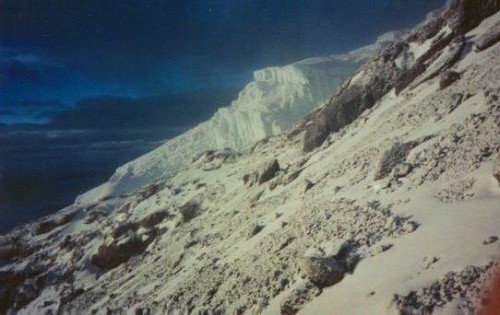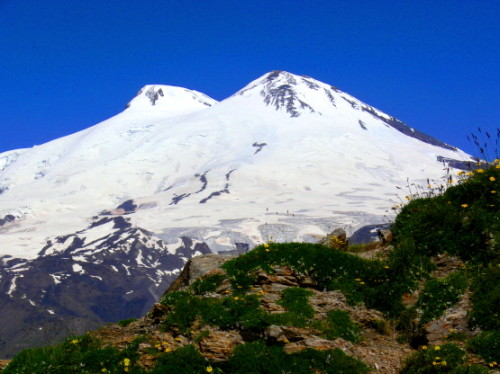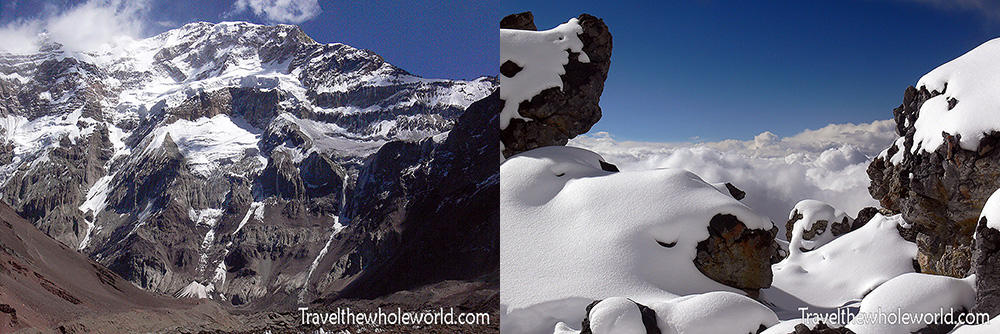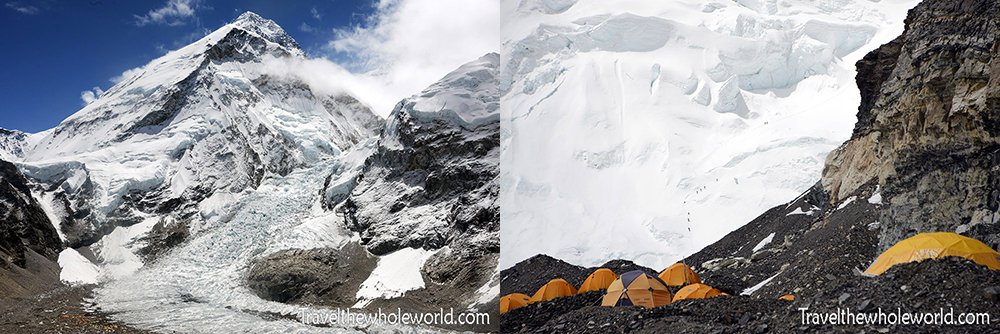Seven Summits
The Seven Summits is a mountaineering challenge to climb the highest peak on all seven continents; a feat accomplished by only a few hundred climbers over the past 25 years. Though these aren’t the seven most difficult mountains in the world, each provides a unique climbing experience and attracts both professional and amateur climbers. The challenges of the Seven Summits range from basic hiking to entering the death zone, which is an area above 8,000 meters where the human body can only survive for a few days. Below is information about each mountain and what challenges can be expected. The photos provide links to the five mountains I have so far climbed and detail those expeditions.
Kilimanjaro

Location: Tanzania, Africa – Altitude: 19,340 Feet – 5,895 Meters – Cost: $1500 – Duration: 5 days – Success Rates: 50%
Mt. Elbrus

Location: Russia, Europe – Altitude: 18,510 Feet – 5,640 Meters – Cost: $1000 – Duration: 5 Days – Success Rates: 80%
Cerro Aconcagua
The High Climb – The highest mountain in the world outside of Asia, Aconcagua gives climbers a chance to experience a high altitude major mountain expedition without dangerous slopes or technical climbing. At nearly 23,000 feet, Aconcagua is significantly harder on every level compared to Elbrus. Those who were able to climb Kilimanjaro or Elbrus without any hard training most likely won’t have the same luck on Aconcagua. Simply being in good shape is not sufficient and a dedicated training program will be required for most to reach the summit. Many successful climbers of Kilimanjaro who had no responsibilities other than hiking in warm weather for less than a week mistakenly believe Aconcagua to be a similar challenge. The demands of a long expedition, heavy backpacks, extreme altitude, and the cold and violent wind storms come as a shock to many. As a result, about 70% of all climbers who attempt Aconcagua will fail.
Location: Argentina, S America – Altitude: 22,841 Feet – 6,962 Meters – Cost: $2500 – Duration: 18 Days – Success Rates: 30%
Denali
The Brutal Climb – Unlike most of the other Seven Summits, there are no porters or guides that are able to help carry your gear on Denali. While climbers on Mt. Everest will carry only a daypack, those on Denali will have up to 150 lbs of gear to haul between their backpack and sled in one of the coldest places on the planet. This makes Denali one of the greatest physical challenges in the world and certainly the most challenging in the western hemisphere. At over 20,000 feet, Denali’s height is higher than Kilimanjaro and Elbrus, but the low pressure of the Arctic and extreme distance from the equator have an effect on the body that makes it equal to several thousand feet higher. Some climbers who have frequently gone above 5,000 meters without issues find themselves out of breath and with altitude problems at only 4,000 meters on Denali. The unusually high number of altitude sickness problems combined with severe weather, temperatures that easily reach -40F, and being just two degrees south of the Arctic circle literally expose climbers to some of the most hostile and miserable environments on earth. Through tough screening and required training courses, many unprepared climbers are rejected from joining an expedition. Of those who pass the requirements and are able to attempt Denali, only half of the well trained and in shape expedition members will make the summit.
Location: Alaska, N America – Altitude: 20,237 Feet – 6,168 Meters – Cost $6000 – Duration: 25 Days – Success Rates: 50%
Carstensz Pyramid
The Rock Climb – While Carstensz Pyramid is the shortest of the Seven Summits, it makes up for its lack of height by being the most technical climb. The true adventure in Carstensz Pyramid however, isn’t even summitting the mountain but getting to the mountain itself. Some less adventurous climbers occasionally take a helicopter all the way to 14,000 feet and do the final summit push in a matter of hours. The real climb though will have a flight drop you off in a village where you’ll do a week long trek through thick muddy rainforests and bogs until reaching base camp. The technical part of Carstensz Pyramid includes rock climbing, scrambling, and jamaring up vertical walls. For most climbers, the biggest challenge of this mountain is probably racking up the funds; only $10,000 to join this expedition. The main issue with the cost of climbing this mountain is a large gold mine located nearby which is guarded by a corrupt military known to open fire on trespassers. Some who have attempted to cross the gold mine have literally disappeared, while others were robbed or arrested. This problem leaves only two ways to legally climb the mountain, both include paying the country’s hefty climbing permit fee, then either hiring a helicopter to fly over the gold mine or staying well clear of the mine by doing the long jungle trek each way to base camp. Of course, the jungle trek costs significantly less than hiring a helicopter, but since the local tribesmen quickly discovered the amount of money they could charge people trying to cross through their land, it isn’t as cheap as you might think.
Location: West Papua, Oceania – Altitude: 16,023 Feet – 4,884 Meters – Cost $10,000 – Duration: 15 Days: Success Rates 99%
Mt. Vinson Massif
The Cold Climb – Attempting Vinson Massif is very similar to climbing Denali and is actually an easier mountain overall, with the only exception being colder weather. Vinson is 4,000 vertical feet shorter than Denali, so less time is needed to acclimatize. Saving time acclimatizing means a shorter expedition, less supplies, and a lighter pack. Since Vinson Massif is located in Antarctica at the bottom of the world, it is the most difficult of the Seven Summits to reach due to the expensive and complicated logistics. Like Carstensz Pyramid, for most climbers getting the funds is usually the most challenging part of the trip. At $35,000 for the climb, you can bet anyone willing to throw down that kind of money is going to be in top shape to guarantee they don’t waste 30 grand. By the time you’re this late in the game, almost all expeditions members are very experienced and knowledgeable, and at least a few expedition members likely already climbed Mt. Everest.
Location: Antarctica – Altitude: 16,067 Feet – 4,897 Meters – Cost: $35,000 – Duration: 15 Days – Success Rates: 99%
Mt. Everest
The Climb – Only a handful of mountains in the world are harder to climb than Mt Everest. Mt. Everest pretty much takes some of the extremes out of each of the Seven Summits and packs them all together in a single challenge. It is over a vertical mile higher than Aconcagua, has temperatures that dip well below zero, and requires technical climbing skills. Success on the rest of the Seven Summits usually depends on how well the climber trained and was prepared. On Mt. Everest however, even the fittest climber or most experienced is still likely to fall victim to the extreme altitude and fatigue of such a long climb. While a Denali expedition usually lasts around three to four weeks in length, Everest expeditions take more than two months. The duration of being in such miserable and physically demanding conditions for such a long period of time combined with the effects of the altitude almost make this climb as much of a mental challenge as a physical one. Death rates before the 90s were usually around 30% of the expedition, but modern technology and a deeper understanding of high altitude effects on humans have drastically reduced the toll.
Location: Nepal, Asia – Altitude: 29,028 Feet – 8,848 Meters – Cost $65,000 – Duration: 70 Days – Success Rates: 20%
My interests in the Seven Summits first began after I climbed Kilimanjaro in 1999. Back then at the age of 18, I never saw climbing all the Seven Summits as a realistic goal, but I definitely thought it would be fun to do try to do some of the easier ones. While I was in the Marines in 2002, I put in a request to go to Russia to try to climb Mt. Elbrus, the summit of Europe. The request that I put in was denied due to manpower issues but I was assured that I could go in the future. As time passed by my interests began to fade and I found myself content with having climbed only Kilimanjaro.
Four years later I was out of the military with a new job and I found myself considering Elbrus again. What inspired me about this trip was not necessarily Elbrus itself, but that the Caucasus region had several tiny countries that I could easily backpack in a single trip. To me Elbrus would simply be an added bonus. Since the climb would only take a week it left me with plenty of exploring time for other countries. In the summer of 2006 I was able to get the time off I needed and had a successful climb of Elbrus, checking off two of the Seven Summits. You might assume that climbing another one of the Seven Summits brought back my motivation, but it was actually after Elbrus I decided I would not pursue the remaining five mountains. In all honesty I climbed Elbrus while I was sick, had a near death experience, and lost 10 lbs in a week, and this was the second easiest of the entire challenge! The remaining climbs would need a minimum of a month vacation time each and I’d much rather be exploring other countries than spending a year’s worth of vacation being miserable on a mountain. Since Kilimanjaro and Elbrus where the easy ones I also questioned my ability for the remaining mountains. The physical and financial challenges that I would have to endure seemed overwhelming if not impossible for an average person like me.
There was no defining moment that changed my mind about the Seven Summits. For some unknown reason only a year later in 2007 I noticed that I suddenly began to think about Aconcagua a lot, even dream about it. My dreams were random.. Sometimes I’d be climbing the mountain, other times I was in the airport on the way to Argentina, and a few times even standing on the summit. My desire to try another one of the Seven Summits began to get strong enough that I worried I might start losing sleep at night. Finally I talked to my boss who was surprisingly supportive and helped give me the time off I would need for Aconcagua.
In February 2008 I had a successful expedition and climbed the 2nd highest of the Seven Summits. I somehow dedicated myself to training several days a week, took climbing courses, and in June 2009 I climbed what I once thought was impossible, Denali, the second hardest of the Seven Summits. In 2011 I continued towards my dream by reaching the top of Oceania after conquering Carstensz Pyramid and its miserable rainforests. At this point, there is no doubt that I am capable of climbing Vinson Massif so my only unknown is Mt. Everest. I’d like to try to Vinson Massif next although getting the funds or sponsorship will be another challenge.
Everyone’s reason for attempting the Seven Summits are different but for me I see this more as a traveling goal than a climbing one. Just like I want to see the unique places in every country in the world, I also believe that the tops of all seven continents are special places to reach. While I do appreciate the physical and mental challenges that climbing has to offer, I don’t consider myself a mountaineer or plan to join any major mountain expeditions beyond these. Most avid climbers counter “there is always another mountain,” but I feel like the Seven Summits offer a little bit of everything in the climbing world and would satisfy my climbing goals.




